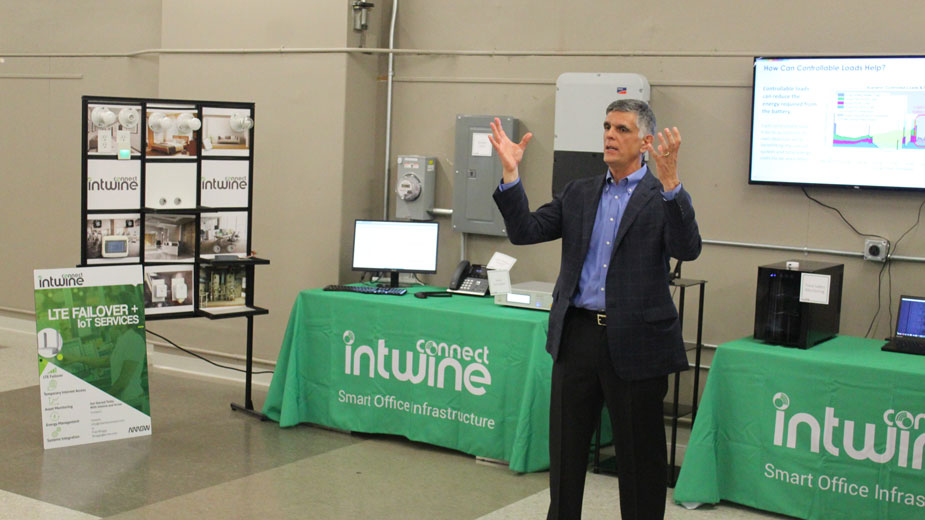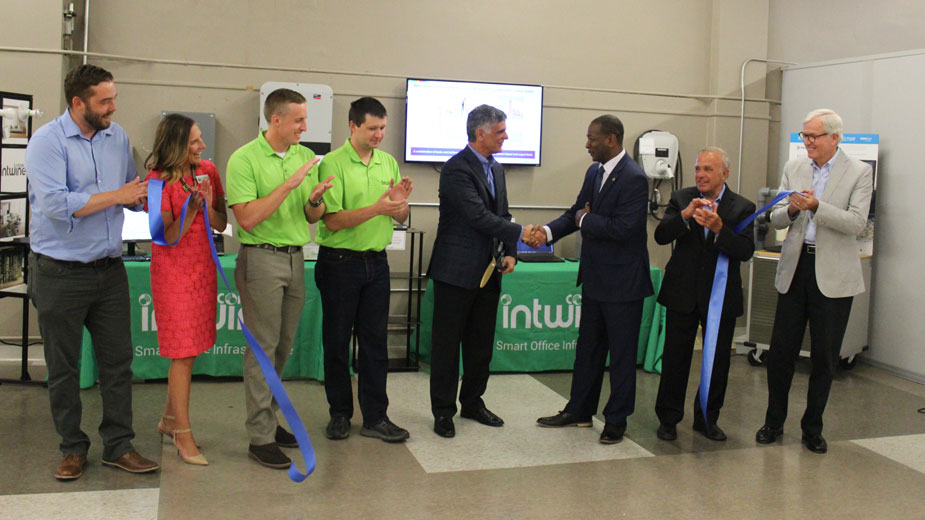Intwine Connects IoT, Energy Efficiency at TBEIC
WARREN, Ohio – With help from the lab at the Tech Belt Energy Innovation Center, the incubator’s newest tenant is preparing to deliver Internet of Things connectivity to area businesses, while also delving into increasing energy efficiency.
Founded six years ago, Intwine Connect LLC held its ribbon cutting at TBEIC Monday night.
“That [six years] was all the ‘R,’ the research. Now we’re into development,” said CEO Dave Martin. “We’d like to commercialize right out there in [Courthouse Square] to create an environment where we can connect small and medium businesses to their community.”
Intwine offers bundle-style services, connecting voice over internet protocol phone service, two-in-one modems and routers, and Internet of Things, or IoT, management. With devices connected to a network, whether an internal system or the internet at large, it allows for such devices to communicate with each other and automated systems to be implemented.
“It’s a significant improvement to efficiency and productivity of a business. It allows you to identify and solve potential events that can negatively impact a business,” Martin explained. “For instance, if there’s a water break, you can detect it early and deploy maintenance, which leads to significant cost savings and mitigation.”
In turn, bundling a business’ IoT into other services removes some of the management aspects from their plates, as some systems put each device on their own network while complex networks can require a dedicated IT team to handle.

“We have a pizza shop that checked their temperatures at open, shift change and at the end of the day. They walk up to a thermostat, write it down on a piece of paper, put it into a spreadsheet and email it to an office,” he said. “We’re able to take all of that and put it online to something’s that downloadable and automate so it doesn’t have to be part of the operational process.”
But the Internet of Things alone isn’t the company’s focus. Intwine is also looking into how IoT devices can improve energy efficiency. Inside its new space in the TBEIC lab, Intwine has an electrical system that works as a “building within a building,” said chief engineer Ryan May, and allows for the simulation of a solar-powered grid, with a refrigerator, an electrical vehicle charging station, lamps, a water heater and a pool pump connected.
Among the chief concerns with solar power is what’s known as the “California duck curve.” Due to the large volume of solar panels in the state, a gap is created between stored power and load during the day that’s inverted in the evening as people end their work day.
“There’s a huge spike in the load and not enough generators. Utilities churn out a lot of expensive generation to accommodate that. We want to flatten that so the generation is a little more equal,” May explained, noting Intwine has deployed testing in Pensacola, Fla., City University of New York and Case Western Reserve University.
IoT devices, meanwhile, can be coordinated – such as turning off devices or using them for energy storage – “so you can both meet the needs of utility but, more importantly to us, add benefit and value to the owner by doing things like reduce the energy bill,” he continued.

Currently, Intwine has about 900 phone customers and 800 using the company as an internet service provider. As those numbers grow, partnerships with technology companies are going to be crucial, Martin said. Already, Intwine is working with Siemens (which made the electric vehicle charger in the lab) and Pentair (the pool pump) and is in talks with Mitsubishi to add IoT products to the lab.
“Our dream is to someday be bigger than the cable companies. We want to be delivering service to small-to-medium businesses,” Martin said, as well as a provider of open standard technology, which would allow other businesses to build upon the tech.
Such partnerships benefit not only companies like Intwine that develop the connections, but all tenants at the Tech Belt Energy Innovation Center, said the incubator’s CEO, Rick Stockburger.
“Those first customer acquisitions are the most important thing to growing a scalable business,” he said. “Just having them here means they’re not only talking to Intwine, but other companies who are here. It’s one company, two companies, three companies and it becomes a flywheel.”
Intwine is also partnering with Verizon Wireless, which could provide a boost as the cellular service expands 5G service into Ohio later this year.
“We’re great at putting out a best-in-class wireless network, but we traditionally don’t build hardware,” said Verizon’s manager of IoT partnerships, David Zeidan. “That’s why we rely on companies like Intwine to go out there and position solutions that help customers connect through Verizon’s network and get the information they need.”
By the end of the year, he added, Verizon will have 5G service in Cleveland, Columbus and Cincinnati.
“Technology always has uncertainty at the beginning, but I know the carriers are committed to it, so I think it’ll be significant,” Martin said. “It’s not just bandwidth, it’s latency. It decreases the delay and it’s lower powered, so it allows battery-operated devices to last longer. There are a number of features to 5G that will be compelling for businesses and industry.”
Pictured: Cutting the ribbon at Intwine Connect LLC’s new lab were Tech Belt Energy Innovation Center CEO Rick Stockburger, lieutenant governor’s regional liaison Monica Blasdel, Intwine senior product manager Jim Basar, Intwine chief engineer Ryan May, Intwine CEO Dave Martin, Warren Mayor Doug Franklin, Trumbull County Commissioner Frank Fuda and Tbeic board chairman John Pogue.
Copyright 2024 The Business Journal, Youngstown, Ohio.



